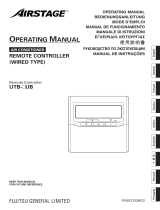
16
OPERATING TIPS
● If the power supply to the air conditioner is interrupted by a
power failure, the air conditioner will restart automatically in
the previously selected mode once the power is restored.
●
Use of other electrical appliances (electric shaver, etc.) or nearby
use of a wireless radio transmitter may cause the air conditioner to
malfunction. In this event, temporarily disconnect the power supply,
reconnect it, and then use the remote controller to resume operation.
AUTORestart
Multi-splittypeAirconditioner
InEventofPowerInterruption
SimultaneousUseofMultipleUnits
Notices
● During use of the heating mode, the top of the indoor unit
may become warm, but this is due to the fact that refrigerant
is circulated through the indoor unit even when it is stopped;
it is not a malfunction.
●
During use of the heating mode, the outdoor unit will occasionally
commence the defrost operation for brief periods. During the
defrosting operation, if the user sets the indoor unit for heating
again, the defrosting mode will continue, and the heating opera
-
tion will begin after completion of defrosting, with the result that
some time may be required before warm air is emitted.
SELF-DIAGNOSIS
TEMPERATURE AND HUMIDITY RANGE
For the permissible ranges of temperature and humidity, refer to the installation manual.
When “Er” in temperature indicator is displayed, inspection of the air conditioning
system is necessary. Please consult authorized service personnel.
Unit number (usually “00”)
Error code
ex. Self-diagnosis check
This indoor unit can be connected to a multi-
split
type outdoor unit. The multi-
split
type air conditioner allows multiple indoor units to be
operated in multiple locations. The indoor units may be operated simultaneously, in accordance with their respective output.
●
When using a multi-split type air conditioner, the multiple indoor
units can be operated simultaneously, but when 2 or more indoor
units of the same group are operated simultaneously, the heating
and cooling eciency will be less than when a single indoor unit
is used alone. Accordingly, when you wish to use more than 1
indoor unit for cooling at the same time, the use should be con
-
centrated at night and other times when less output is required.
In the same way, when multiple units are used simultaneously
for heating, it is recommended that they be used in conjunction
with other auxiliary space heaters, as required.
●
Seasonal and outdoor temperature conditions, the structure of
the rooms and the number of persons present may also result
in dierences of operating eciency. We recommend that you
try various operating patterns in order to conrm the level of
heating and cooling output provided by your units, and use
the units in the way that best matches your family’s lifestyle.
● If you discover that 1 or more units delivers a low level of cool-
ing or heating during simultaneous operation, we recommend
that you stop simultaneous operation of the multiple units.
●
Operation cannot be done in the following dierent operating
modes. If the indoor unit is instructed to do an operating mode
that it cannot perform,
will be shown on the remote
controller display and the unit will go into the standby mode.
●
Operation can be done in the following dierent operating modes.
●
The operating mode (heating mode or cooling (dry) mode) of the
outdoor unit will be determined by the operating mode of the indoor
unit that was operated rst. If the indoor unit was started in fan mode,
the operating mode of the outdoor unit will not be determined. For
example, if indoor unit (A) was started in fan mode and then indoor
unit (B) was then operated in heating mode, indoor unit (A) would
temporarily start operation in fan mode but when indoor unit (B)
started operating in heating mode,
will be shown on the unit
(A) remote controller display and it would go into standby mode.
Indoor unit (B) would continue to operate in heating mode.
• Heating mode and cooling mode (or dry mode)
• Heating mode and fan mode
• Cooling mode and dry mode
• Cooling mode and fan mode
• Dry mode and fan mode
9381857135-01_OM_200819.indd 16 2020/09/02 9:56:17

















